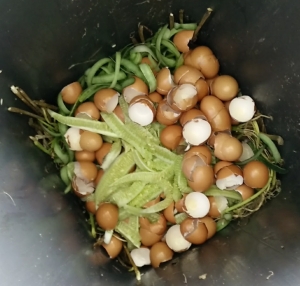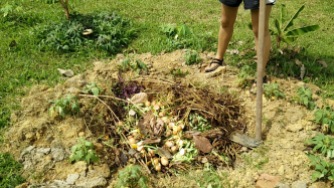
Food waste collected in a bin
We started food waste composting a few months ago in the garden at the Canossian School. The food waste comes from the children’s home and the sisters’ quarters. We have a food waste bin each outside the two kitchens that we collect once or twice every week. The chefs throw fruit peels, vegetables cuttings, and egg shells into the bins. We don’t take dairy, meat, and oil because they are much harder to compost. The smell will be stronger and there will be more pests like rodents.
Most people associate food waste with stench. It can be true because food waste tends to be high in moisture and nitrogen. It breaks down fast and the process can become anaerobic (no air) since it’s so wet. That causes the smell. To solve this issue, one can add materials that are high in carbon and low in moisture. Some materials that would work include sawdust, wood chips/clippings, dried leaves, old newspaper/cardboard, and straw.
Fortunately for us, there is a ready source of dried leaves in the school. They frequently sweep up the fallen leaves around the compound to throw away. We convinced them to keep all of it for us. We would fill half the empty bin with dried leaves before we return the bins. When we collect them, the food waste would be on top of the leaves which would have absorbed lots of moisture. It still smells a little especially if the food waste to dried leaves ratio is high. A more absorbent and higher carbon material like sawdust or wood chips would work better, but we try to use what we have onsite.

Quite a lot of dried leaves waiting to be used every week!
We would then push the wheeled bins to the back of the garden where we have dug some pits. They are similar to banana circles except we have not planted bananas (yet?) around them. We would tip the bins over and empty the food waste while holding our breaths. After that we would use the hoe and bury the food waste under the leaves.
This is the second pit that we dug, approximately 1.5m diameter and 0.5m deep. It filled up very quickly in less than 2 months! It worked great and the only time it smells is right after we pour the wet food waste in. The smell stops after we mix it in.
And so, we decided to dig a third and bigger pit. This time it was 2.5m in diameter and 0.5m deep. We could not go deeper because of the construction waste that was buried beneath the soil. As expected, it filled up again quickly and we would have to dig another pit soon!
Lazy Way of Food Waste Composting
If you want to, composting can get very scientific and precise. Some of the things you can do include:
- Ensuring the exact carbon-to-nitrogen ratio
- Inoculating with proprietary micro-organisms (Bokashi, Effective Micro-organisms)
- Measuring temperatures with a thermometer
- Dimensions of the compost pile
- Schedule for flipping the pile
- Aeration techniques
Our method is lazier and easier compared to that. The food waste wouldn’t break down as fast into compost. However it is much easier and practical for our purpose. We compost on a small scale, receiving unpredictable amounts and contents of food waste once or twice a week. We try not to rely on bringing in outside materials like sawdust as well. Our key concern is not to stink up the whole school. At the end of the day, it would still break down and become available as nutrients for living plants. In fact, when we dug up our previous pits we saw some nicely black and moist compost. After all, nature isn’t that picky. No rush!








Good job! I feel encouraged to see how you leverage on what you have to make things work. 👍🏻
Thanks Audrey! We just wanted to show that composting can be done by everyone. No need for expensive machines (those you see at hawker centers) or rocket science…
Pingback: A False Sense of Food Security in High-tech Farming | INTO THE ULU